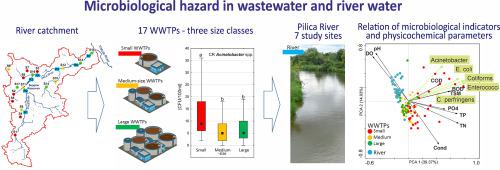Science of the Total Environment ( IF 8.2 ) Pub Date : 2020-09-14 , DOI: 10.1016/j.scitotenv.2020.142266 Liliana Serwecińska , Edyta Kiedrzyńska , Marcin Kiedrzyński

|
Urbanization and population growth have created considerable sanitation challenges in cities and communities in many parts of Europe and the world. As such, it is imperative to identify the most environmentally-harmful microbiological and chemical sources of pollution, these being wastewater treatment plants (WWTPs) which release wastewater of low quality. In the present manuscript, an extensive study was performed of the sanitary conditions of river water and treated wastewater from seventeen WWTPs of various sizes along the Pilica River catchment in central Poland, with the aim of identifying “hot spots” in terms of most serious sources of sanitary hazards. The bacteriological risk for the river, including fecal indicator bacteria (FIB) such as coliforms, E.coli, enterococci, C. perfringens, and carbapenem-resistant Acinetobacter spp. (CRA) were assessed using classical microbiological methods, and the physicochemical parameters were also tested. The WWTPs, particularly the small ones (<2000 people equivalent, PE) demonstrated significant variation regarding the physicochemical parameters. Carbapenem-resistant Acinetobacter spp. bacteria growing at 42 °C were found in the effluent wastewaters of all tested municipal WWTPs, and in most of the Pilica River water samples, presenting a potential hazard to public health. A positive correlation was identified between E. coli and CRA abundance in treated wastewater; however, no such relationship was found in river water. It was found that seven small treatment plants discharged wastewater with very different microbiological parameters. Moreover, three small treatment plants serving only 0.56% of the population in the studied area continuously released extremely high microbiological contamination, constituting as much as 54–82% of fecal indicator bacteria loads in the area studied. Our findings show that this type of comprehensive analysis may enable assessment of the use of the entire catchment area, thus identifying the most serious threats to surface water quality and guiding the actions needed to improve the worst operating WWTPs.
中文翻译:

基于粪便指标和耐碳青霉烯的不动杆菌属的流域规模评估处理后废水和河水的卫生状况
城市化和人口增长给欧洲和世界许多地方的城市和社区带来了巨大的卫生挑战。因此,必须确定对环境最不利的微生物和化学污染源,它们是释放低质量废水的废水处理厂(WWTP)。在本手稿中,对波兰中部皮利卡河集水区17个不同规模的污水处理厂的河水和处理废水的卫生条件进行了广泛的研究,目的是从最严重的来源中识别“热点”卫生危害。河流的细菌学风险,包括粪便指示细菌(FIB),例如大肠菌,大肠杆菌,肠球菌,产气荚膜梭菌和耐碳青霉烯的不动杆菌属。(CRA)使用经典的微生物学方法进行评估,还测试了理化参数。污水处理厂,特别是小型污水处理厂(<2000人当量,PE)在理化参数方面表现出显着差异。耐碳青霉烯的不动杆菌属 在所有测试的城市污水处理厂的废水中以及大多数皮利卡河水样品中都发现了在42°C下生长的细菌,对公共健康构成潜在危害。在大肠杆菌之间鉴定出正相关处理后的废水中的CRA含量丰富;但是,在河水中没有发现这种关系。结果发现,有七个小型污水处理厂排放的废水中微生物参数差异很大。此外,三个仅占研究区域人口0.56%的小型处理厂连续释放出极高的微生物污染,占研究区域粪便指示菌负荷的54-82%。我们的研究结果表明,这种类型的综合分析可以评估整个集水区的使用情况,从而确定对地表水水质最严重的威胁,并指导采取必要的行动来改善最恶劣的污水处理厂。











































 京公网安备 11010802027423号
京公网安备 11010802027423号